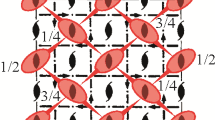Abstract
This paper deals with the construction of crystal lattices of ionic compounds of composition AX2 based on close packing. If the ratio of the ionic radii satisfies the inequalityrA/rX≥0,732, then the construction is very similar to that of CsCl and the lattice is built up from close-packed ionic planes which contain both the anions and cations, respectively, in the adequate ratio. In this case only one solution is possible, namely the CaF2 lattice. If the ratio of the ionic radii satisfies the inequality 0,732 ≥rA/rX≥0,414 the solution can be found by investigating several possibilities of uniform cationic distributions in the octahedral cavities of the different spatial close-packed anionic frames which satisfyPauling’s coordination principle. Many such solutions can be found, several of them giving the lattice of rutile and its sister lattices with different chemical composition and cationic distribution, the lattice of brookite and anatase. However, no actual crystal lattices have been found till now, corresponding to some of the possibilities.
The actual crystal lattices are almost always distorted and dilated compared to the ideal ones built by close packing, but for the isotypic lattices forming a group the difference volume associated with one anion has to be the same. With this supposition the author was able to show that a deviation from this rule occurs in the crystal lattices of compounds AB2X6 when the divalent A cations are Fe, Co, Ni, or Mn. The most serious deviation can be found in the case of Fe. Another deviation can be found in the compounds AAs2O6 which has to be attributed to the influence of As+5 causing an apparent decrease of the ionic radii of the divalent cations A.
Резюме
В данной работе исследуется строение кристаллов ионов состава AX2 на основании принципа плотнейшей упаковки. Если отношение радиусов обеих ионовrA/rX≧0,732, решетка может быть построена, как и в случае CsCl, из плотно упакованных ионных плоскостей, которые состоят из катионов и анионов, отношение которых определяется химическим составом. В этом случае возможно только одно решение, это и есть решетка CaF2.
Если отношение радиусов ионов 0,732≧rA/rX≧0,414, возможные кристаллические решетки получаются следующим путем: в октаэдрических зазорах различных, плотно упакованных анионных решеток, которые на половины заполнены катионами, следует поискать те равномерные распределения катионов, которые удовлетворяют координационному принципу Паулинга. Возможно несколько таких решений; к таким относятся рутил и родственной структуры вещества, даже и в том случае, если химический состав последних и отличается от рутила. Сюда относятся и структуры брукита и анатаза. Среди теоретически возможных идеальных случаев встречается несколько таких, в которых кристаллизующие ся вещества по настоящее время пока не найдены.
Реальные кристаллические решетки по сравнению с идеальными, полученными предположением о плотной упаковке, почти во всех случаях искажены и имеют немного увеличенный объем. Среди однотипных структур в каждой изотипной группе разница в объеме, падающая на один анион, для всех членов изотипных групп является одной и той же. Автором показывается, что у родственных структур рутила состава AB2X6 обнаруживается отклонение от данного правила, если катионом А является Fe, Co, Ni или Mn. Наибольшее отклонение имеется в случае Fe. Интерпретация о данном явлении сообщается позже. Другое расхождение наблюдается у соединений состава ASb2O6 и AAs2O6. В этом случае большой удельный заряд As+5 повидимому уменьшает радиус катионов и, таким образом, разность объема, падающая на один анион, у соединений AAs2O6 будет меньше, чем у соединений ASb2O6.
Similar content being viewed by others
References
K. Sasvári, Acta Phys. Hung.,8, 245, 1957.
I. Náray-Szabó, Naturwiss.,31, 466, 1943.
N. Schönberg, Actá Chem. Scand.,8, 617, 1954.
K. Sasvári, Acta Phys. Hung.,11, 333, 1960.
A. Magnéli andG. Anderson, Acta Chem. Scand.,9, 1378, 1955.
K. Brandt, Ark. Kemi, Min. Geol.,17A, No. 15, 1943.
L. W. Vernon andW. O. Milligan, The Texas J. of Science,1, 82, 1951.
A. Byström, B. Bök andB. Mason, Ark. Kemi, Min. Geol.,15B, No. 4, 1941.
G. L. Clark andD. A. Reynolds, Z. Krist.,98, 185, 1938.
E. Tavora andF. Peixoto, An. Acad. Brazil. Cienc.,23, No. 4, 449, 1951.
A. I. Vaslavskij, Ju. D. Kondrasov andS. S. Tolkacev, Dokl. Akad. Nauk. SSSR,75, 559, 1950.
A. Magnéli, Acta Cryst.,9, 1038, 1956.
A. Magnéli, Acta Chem. Scand.,11, 28, 1957.
K. Dihlström, Z. anorg. allg. Chem.,239, 57, 1938.
A. Magnéli, Ark. Kemi, Min. Geol.,15B, No. 3, 1941.
L. Pauling andJ. H. Sturdivant, Z. Krist.,68, 239, 1928.
T. Ito andH. Sawada, Z. Krist.,102, 13, 1939.
Ch. Legrand andJ. Delville, C. R.,236, 944, 1953.
Author information
Authors and Affiliations
Rights and permissions
About this article
Cite this article
Sasvári, K. On the construction of the lattice of ionic crystals from the viewpoint of close packing II. AX2 . Acta Physica 11, 353–390 (1960). https://doi.org/10.1007/BF03160432
Received:
Issue Date:
DOI: https://doi.org/10.1007/BF03160432



